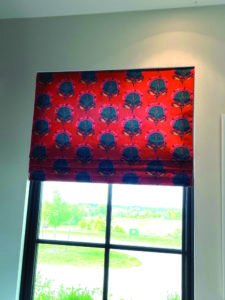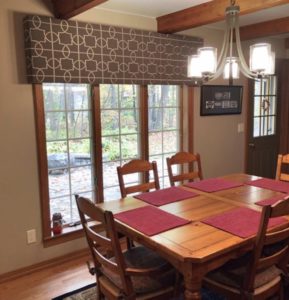Room with a View
Windows Treatments to Elevate Your Space
“Frame the view.”
Three small words make a big impact in terms of interior design.
Window treatments, which area expert Lori Burr, owner of Sew Biz Drapery and Blinds, LLC in Neenah, defines as “anything you put on a window, but not window film,” transform a space. And in reality, she says, they complete the look altogether.

“It’s a huge part of the look. People who don’t do window treatments are missing out on a whole layer of design.”
“I see window treatments as a basic design element of the room,” Jane Hamilton, owner + Lead Design Consultant of The Blind Lady Custom Blinds in Menasha, adds. “It’s similar to when you are applying makeup; if you do everything but the eyes, your face isn’t done. Window treatments can add the accent needed to the room… giving (it) a finished and polished look.”
The Basics + Design Functionality
While “the basics” are just that, determining what works both functionally and aesthetically—and combining the two—can feel complicated based on seemingly endless choices.
Hard treatments are always operational and consist of blinds, shades and shutters. Soft treatments can be functional but also solely aesthetic and are anything made out of fabric: draperies, curtains, sheers and valances.

“Hard treatments are manufactured and custom ordered to fit your window,” Lisa Prellwitz, seamstress and upholsterer at Sew Biz Drapery and Blinds, LLC says. “With soft treatments, you pick the fabrics, the style, what kind of hardware you want. Do you want it mounted on a board? Do you want upholstered cornices? Valances? Panels? Are they working, are they nonworking? These are all questions we have to pry out of customers!”
Homelife considerations, such as children and pets, should play a significant role in narrowing down options.
“Homeowners need to consider their lifestyle when picking out window treatments,” Diane Fockel-Pima, owner of Fockels Superior Drapery & Blinds in Menasha, says. “Safety is (the) No. 1 priority when children are involved. The industry is trying to eliminate cords by going with cordless and motorized shades.
“Accessibility: Can the window be reached to open and close the blinds? Is the fabric appropriate for small children and pets? That is where a designer can help you with your choices.”
Determining needs for privacy and light control is one of the first steps in helping to determine how to narrow down options for functionality.
“Window treatments can be a blind, shade, drapery or valance to cover the window for privacy, to control lighting, helping keep heat or cold out,” Fockel-Pima says.

“With light control, we have a lot of options,” Burr adds. “Bandage shades are great. Pinch-pleated sheer over privacy shades. Solar screens are hugely popular right now because you can cut the glare, you can cut the heat gain. You don’t get privacy, but you can still live in your room.
“Cafe curtains cover just half of the window and usually just come down to the bottom of the window. Blackout lining adds privacy and to keep it dark in the bedroom.”
Trends in 2022 and Beyond : Color, color, color!
Big, bright patterns are on trend in the window treatment world and that means bold color. Replacing grays and neutrals, blues and greens are back and packing a punch in terms of interior design impact.
“Color is coming back in a big way,” Burr says. “We have one vendor that posts a list of the top 500 selling fabrics from their collection and fully a third of them have blue in it—all different shades of blue.”
“And we’re getting a little bit more of the reds,” Prellwitz adds. “They tried to push the mauve, salmon color but it didn’t go. It’s going back to a deeper color red again.”
The aesthetic is changing in more ways than color. In fact, it’s coming full circle. What was once in style and took a break is coming back.

“Years ago, the trend became a very casual, clean crisp look—very minimalist,” Hamilton explains. “That is still in vogue, but a resurgence in opulent soft treatments with drapery and valances is occurring that was popular back in the day. I see this trend demonstrated by my professional colleagues from the coasts and southern regions of the country. Yards and yards of fabric are used to create stunning treatments that really set the pace of the interior space.
“One of the most dramatic changes that have occurred in the last years has been the addition of many new treatments. Hunter Douglas, the leader in the custom window treatment industry in both design and function has created many new window treatments for the residential designer and homeowner.”
She further explains the new options:
The Sonnette Shade, a combination of the roller shade and a honeycomb shade, creating a dimensional shade offering energy efficiencies and a clean design element.
The Pirouette Window Shading is a treatment that is still under patent by Hunter Douglas; offering you the expansion of a horizontal fabric vane, which protects your furniture from UV rays, diffuses the light and allows one to see out the treatment or close for privacy.
The Vignette Modern Roman Shades uses the elements you love about a roman shade, but gives the added benefit of offering a smaller stack in their rolling shade than a traditional shade. Plus, the shade self-dresses as raised for much less fuss than an old-fashioned roman shade and it always looks great.”
Trending in functionality is battery-operated automation.

“No need to hard-wire, we can use batteries or rechargeable batteries in this system,” Hamilton explains. “The Hunter Douglas Gen 3, our most popular system, offers Bluetooth technology allowing you to create scenes on your devices, operate the shades with your devices or with a remote control and place the shades in your home automation system.”
Window treatments elevate a space—literally. They naturally bring your eyes up to include the top part of the room with the bottom, creating a cohesive space. The architecture and furniture in said room should dictate window treatment style as well, but at the end of the day, homeowners’ personal style is the most important piece of the puzzle.
“We don’t have to live there, you do!” Prellwitz reminds. “It’s not our style, it’s your style that matters.”
“Window treatments should reflect your personality, lifestyle and your decorating scheme, not overpower your room,” Fockel-Pima adds. “Remember, it is your home, you can use any pattern or color that you love. Make it unique!”
“Rules are always made to be broken,” Hamilton says. “Determine your style and find the treatment that has the ‘look’ you’re going for in your room design. Then ask yourself, ‘Does this treatment fit the everyday living that I and my family expect in that space?’”
“Don’t be afraid of checking into custom,” Burr urges. “Go into it with an open mind and a budget in mind. Communication is key.”










Leave a Comment